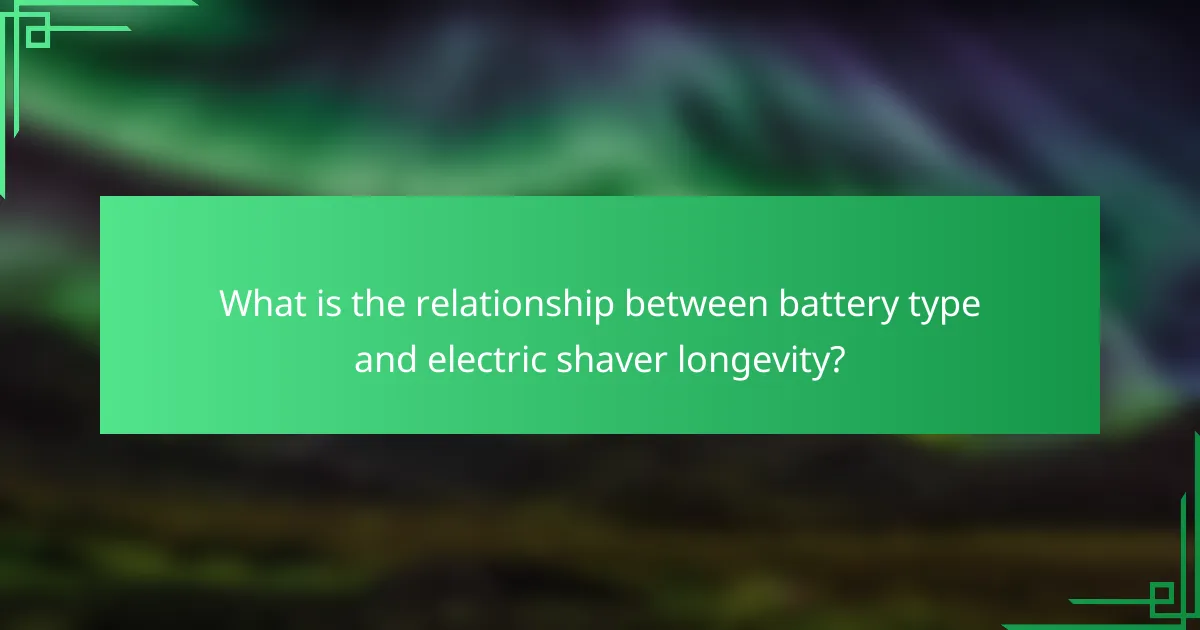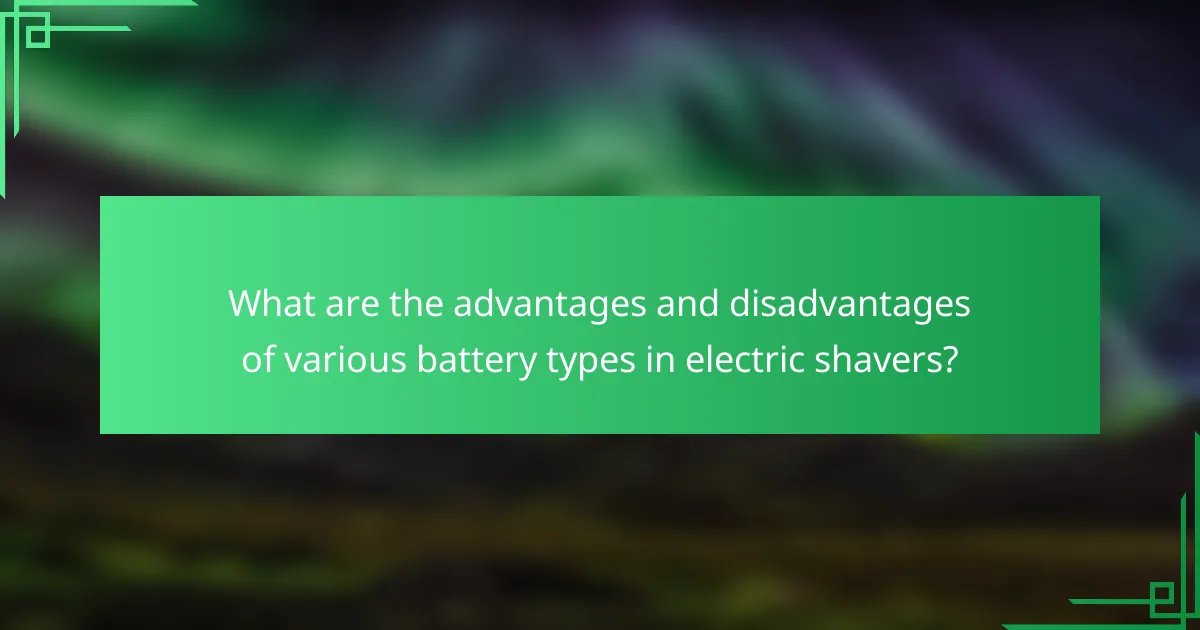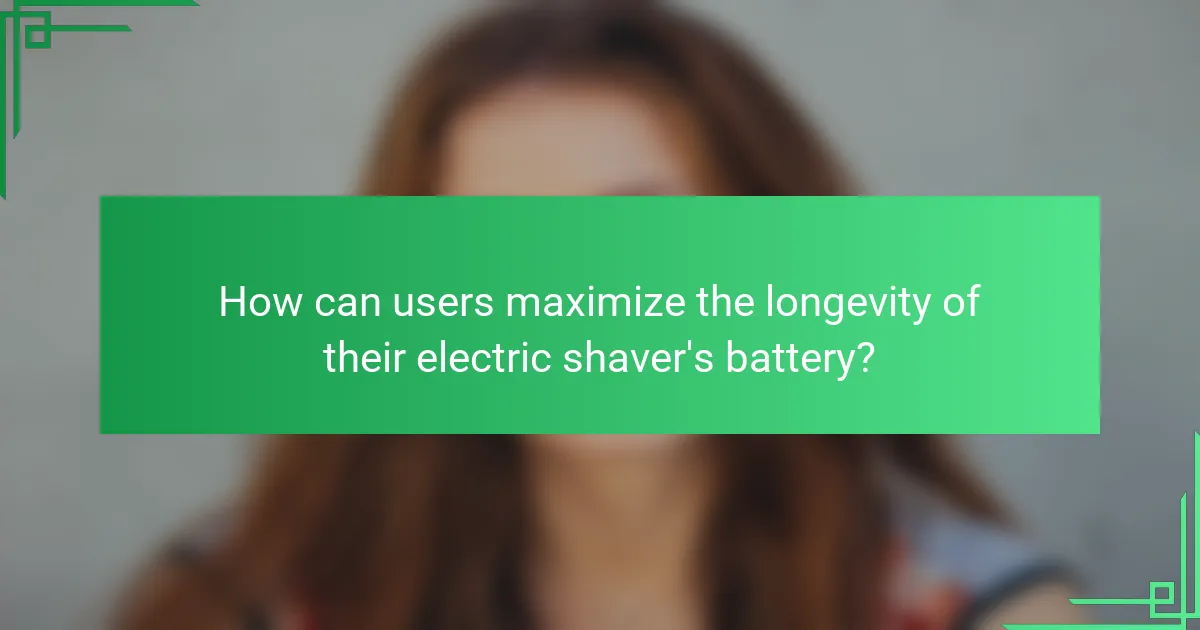Electric shaver longevity is significantly influenced by the type of battery used. Lithium-ion batteries typically outperform nickel-cadmium and nickel-metal hydride batteries in terms of lifespan and charge retention. With a lifespan of up to 500 charge cycles, lithium-ion batteries provide consistent performance and require less frequent replacements. The article will explore the characteristics of various battery types, including their advantages and disadvantages, and offer practical care tips to maximize battery longevity in electric shavers. Understanding these factors is essential for users seeking to optimize their shaver’s performance and lifespan.

What is the relationship between battery type and electric shaver longevity?
The battery type significantly affects electric shaver longevity. Lithium-ion batteries generally offer longer lifespans compared to nickel-cadmium batteries. Lithium-ion batteries can last up to 500 charge cycles, while nickel-cadmium batteries typically last around 300 cycles. Additionally, lithium-ion batteries maintain charge better over time, reducing the frequency of replacements. This results in less downtime and more consistent performance for users. The energy density of lithium-ion batteries also allows for lighter and more compact designs, enhancing user convenience. Studies show that shavers with lithium-ion batteries tend to have a longer operational lifespan in practical use.
How do different battery types affect the performance of electric shavers?
Different battery types significantly affect the performance of electric shavers. Lithium-ion batteries offer longer run times and faster charging compared to nickel-cadmium batteries. Lithium-ion batteries maintain consistent power output throughout their use. In contrast, nickel-cadmium batteries experience voltage drop as they discharge. This can lead to decreased shaving efficiency over time. Additionally, lithium-ion batteries typically have a lifespan of 2 to 3 years, while nickel-cadmium batteries may need replacement sooner due to memory effect. Overall, the choice of battery type directly influences the reliability and effectiveness of electric shavers.
What are the common battery types used in electric shavers?
The common battery types used in electric shavers are nickel-cadmium (NiCd), nickel-metal hydride (NiMH), and lithium-ion (Li-ion). NiCd batteries are known for their durability but suffer from memory effect issues. NiMH batteries offer higher capacity and are less prone to memory effects compared to NiCd. Li-ion batteries are popular for their lightweight design and longer lifespan. They also charge faster and have no memory effect. These attributes make Li-ion batteries the preferred choice for modern electric shavers.
How does battery capacity influence shaver usage time?
Battery capacity directly influences shaver usage time. A higher capacity battery allows for longer operation before needing a recharge. For example, a shaver with a 4500 mAh battery can run for approximately 60 minutes of shaving time. In contrast, a shaver with a 2000 mAh battery may only provide around 30 minutes of usage. This difference arises because the energy stored in the battery determines how long it can power the motor. Additionally, shavers with larger batteries often support more advanced features, which can also affect overall run time. Therefore, battery capacity is a critical factor in determining how long an electric shaver can be used continuously.
Why is battery maintenance important for electric shaver longevity?
Battery maintenance is crucial for electric shaver longevity because it directly affects the performance and lifespan of the device. Proper care ensures that the battery retains its charge capacity over time. Regularly charging the battery prevents deep discharges that can lead to capacity loss. Additionally, maintaining clean battery contacts improves conductivity and efficiency. Overheating can damage batteries, so keeping the shaver cool during use is essential. Studies show that lithium-ion batteries, commonly used in electric shavers, can last significantly longer with proper maintenance. For instance, a well-maintained battery can last up to 500 charge cycles, whereas neglect can reduce this to as few as 300 cycles. Thus, consistent battery care leads to optimal performance and extended device life.
What maintenance practices can extend battery life in electric shavers?
Regular maintenance practices can significantly extend battery life in electric shavers. Cleaning the shaver after each use prevents hair buildup, which can strain the motor and battery. Lubricating the blades reduces friction, enhancing efficiency and reducing battery drain. Avoiding complete discharge of the battery helps maintain its health; lithium-ion batteries perform best when kept between 20% and 80% charge. Storing the shaver in a cool, dry place prevents overheating, which can damage the battery. Additionally, using the manufacturer’s charger ensures optimal charging conditions. These practices collectively contribute to prolonged battery longevity and performance.
How does improper charging affect battery longevity?
Improper charging significantly reduces battery longevity. Overcharging can lead to excessive heat, which damages battery cells. Heat accelerates chemical reactions within the battery, causing degradation. Undercharging can also affect battery capacity and efficiency over time. Lithium-ion batteries, commonly used in electric shavers, are particularly sensitive to charging practices. A study by N. K. Gupta and M. S. Kumar found that improper charging can decrease battery lifespan by up to 30%. Maintaining optimal charging practices is crucial for maximizing battery performance and longevity.

What are the advantages and disadvantages of various battery types in electric shavers?
Lithium-ion, nickel-metal hydride, and nickel-cadmium are common battery types in electric shavers. Lithium-ion batteries offer high energy density and longer lifespan. They can last up to 3-5 years with proper care. However, they can be more expensive to replace. Nickel-metal hydride batteries are cheaper and environmentally friendly. They provide decent performance but have a shorter lifespan, typically around 2-3 years. Nickel-cadmium batteries are known for their durability and ability to perform in extreme temperatures. However, they suffer from memory effect and environmental concerns. Each battery type presents distinct advantages and disadvantages impacting electric shaver longevity.
What are the benefits of using lithium-ion batteries in electric shavers?
Lithium-ion batteries in electric shavers offer several benefits. They provide a longer lifespan compared to other battery types. This longevity is due to their ability to withstand numerous charge cycles without significant degradation. Lithium-ion batteries also charge faster, typically reaching full capacity in one to two hours. This efficiency allows for quick recharges, making them convenient for users. Additionally, they have a higher energy density, which means they can store more energy in a smaller size. This design leads to lighter shavers that are easier to handle. Furthermore, lithium-ion batteries maintain a consistent power output throughout their discharge cycle. This feature ensures that the shaver performs optimally until the battery is nearly depleted. Overall, the use of lithium-ion batteries enhances the performance and user experience of electric shavers.
How does lithium-ion technology enhance shaver performance?
Lithium-ion technology enhances shaver performance by providing higher energy density and faster charging capabilities. This technology allows shavers to operate at optimal power levels for longer durations. Lithium-ion batteries are lighter, contributing to a more ergonomic design. They also have a lower self-discharge rate, ensuring that shavers retain their charge over time. Furthermore, lithium-ion batteries can sustain consistent voltage output, which improves shaving efficiency. Research indicates that devices using lithium-ion technology can achieve up to 50% more usage time compared to older battery types. This results in less frequent charging and greater convenience for users.
What are the potential downsides of lithium-ion batteries?
Lithium-ion batteries have several potential downsides. One major concern is their tendency to overheat. This can lead to thermal runaway, which may cause fires or explosions. Additionally, lithium-ion batteries degrade over time. This degradation reduces their capacity and lifespan, typically lasting 2 to 3 years under normal use.
Another downside is their environmental impact. The extraction of lithium and cobalt can result in significant ecological damage. Furthermore, improper disposal of these batteries can lead to soil and water contamination.
Lastly, lithium-ion batteries can be expensive compared to other battery types. Their higher cost may limit accessibility for some consumers. These factors highlight the importance of considering alternatives when evaluating battery options for devices like electric shavers.
How do nickel-cadmium batteries compare to lithium-ion batteries?
Nickel-cadmium (NiCd) batteries differ from lithium-ion (Li-ion) batteries in several key aspects. NiCd batteries have a lower energy density compared to Li-ion batteries. This means they store less energy for the same weight. NiCd batteries also suffer from memory effect, which reduces their effective capacity over time. In contrast, Li-ion batteries do not have this issue and maintain capacity better with proper usage.
Li-ion batteries typically have a longer lifespan than NiCd batteries. Research indicates that Li-ion batteries can last up to 2,000 charge cycles, while NiCd batteries often last around 1,000 cycles. Additionally, Li-ion batteries charge faster than NiCd batteries, offering convenience for users.
Environmental impact is another consideration. NiCd batteries contain toxic cadmium, which poses disposal challenges. Li-ion batteries are generally considered more environmentally friendly. Overall, Li-ion batteries are preferred for modern applications due to their efficiency, longevity, and lower environmental impact.
What unique attributes do nickel-cadmium batteries offer?
Nickel-cadmium batteries offer unique attributes such as a high discharge rate and ability to perform well in extreme temperatures. They can endure overcharging without damage, providing durability in various applications. Their memory effect allows them to retain charge capacity even after repeated cycles. These batteries also have a long lifespan, often exceeding 1,000 charge cycles. Additionally, they are less susceptible to temperature fluctuations compared to other battery types. Nickel-cadmium batteries can deliver consistent performance, making them reliable for devices like electric shavers. Their robust construction allows them to handle heavy-duty usage effectively.
What rare issues might arise with nickel-cadmium batteries?
Rare issues that might arise with nickel-cadmium batteries include memory effect and toxic cadmium leakage. The memory effect occurs when the battery is repeatedly charged before being fully discharged. This can lead to a reduced capacity for future use. Toxic cadmium leakage can happen if the battery is damaged or improperly disposed of. Cadmium is a hazardous material that poses environmental risks. These issues are not common but can significantly affect battery performance and safety.

How can users maximize the longevity of their electric shaver’s battery?
To maximize the longevity of an electric shaver’s battery, users should follow specific care practices. Regularly charging the battery helps maintain its health. Avoid letting the battery completely discharge before recharging. This can lead to reduced capacity over time. Store the shaver in a cool, dry place to prevent overheating. Overheating can damage battery cells. Clean the shaver after each use to ensure optimal performance. Dirt and hair can strain the motor, affecting battery life. Additionally, use the manufacturer’s charger to avoid compatibility issues. Using the wrong charger can lead to battery damage. Following these practices can significantly extend the battery’s lifespan.
What best practices should users follow for battery care?
To ensure optimal battery care, users should follow specific best practices. First, avoid overcharging the battery. Overcharging can lead to reduced battery lifespan. Second, maintain a moderate temperature during charging. Batteries perform best at room temperature. Third, store the device with a partially charged battery. A 40-60% charge is ideal for long-term storage. Fourth, use the manufacturer’s charger to prevent damage. Using incompatible chargers can harm the battery. Fifth, regularly clean the device to prevent overheating. Dirt can affect battery performance. Lastly, avoid deep discharges. Frequent deep discharges can shorten battery life. These practices help maintain battery health and extend the longevity of electric shavers.
How often should users charge their electric shaver for optimal battery life?
Users should charge their electric shaver after every use for optimal battery life. Regular charging helps maintain battery health and performance. Lithium-ion batteries, commonly used in electric shavers, benefit from frequent charging. They do not have a memory effect, allowing users to charge them at any time. Keeping the battery partially charged can extend its lifespan. Avoiding deep discharges is crucial for maintaining battery integrity. Following these practices enhances the overall longevity of the electric shaver.
What signs indicate that an electric shaver battery needs replacement?
An electric shaver battery needs replacement when it shows signs of reduced performance. Common indicators include the shaver not holding a charge for long periods. Users may notice longer charging times without an increase in usage time. Additionally, the shaver may operate inconsistently or shut off unexpectedly during use. A decrease in power can also be felt, making shaving less efficient. If the battery swells or shows physical damage, it should be replaced immediately. These signs confirm that the battery is failing and requires attention.
What troubleshooting tips can help address battery-related issues?
To address battery-related issues, first check the battery connections for corrosion or looseness. Ensure that the battery is properly seated in the device. If the battery is removable, try replacing it with a new one to see if performance improves. Additionally, clean the battery contacts with a soft cloth to enhance conductivity. If the device is rechargeable, verify that the charger is functioning correctly and providing the proper voltage. Testing the device with a different charger can confirm this. Monitor the device for overheating, as excessive heat can indicate a malfunctioning battery. Lastly, refer to the manufacturer’s guidelines for specific troubleshooting steps related to your model.
How can users diagnose common battery problems in electric shavers?
Users can diagnose common battery problems in electric shavers by observing performance issues. If the shaver does not hold a charge, the battery may be faulty. A noticeable decrease in runtime indicates battery degradation. Users should check for physical damage to the battery or terminals. If the shaver fails to turn on, it may be a sign of a dead battery. Testing the charger can also help identify issues. A charger that does not light up suggests a problem. Lastly, users can consult the manufacturer’s guidelines for specific troubleshooting steps.
What steps should be taken if the battery performance declines unexpectedly?
Check the battery connections for any loose or corroded contacts. Clean the terminals with a soft cloth if necessary. Next, ensure the battery is charged properly. Use the manufacturer’s recommended charger and follow the charging guidelines. If performance does not improve, consider recalibrating the battery. This involves fully discharging and then fully charging the battery. If issues persist, replace the battery with a compatible one. Research indicates that lithium-ion batteries can degrade over time, affecting performance. Regular maintenance can prolong battery life and efficiency.
The main entity of this article is electric shavers, specifically focusing on the impact of battery type on their longevity. The article examines how different battery types, such as lithium-ion, nickel-cadmium, and nickel-metal hydride, influence the performance, lifespan, and maintenance of electric shavers. Key points include the advantages of lithium-ion batteries, including longer charge cycles and better power consistency, as well as the drawbacks of other battery types. Additionally, the article provides insights into battery maintenance practices, common issues, and troubleshooting tips to maximize battery life and ensure optimal shaver performance.